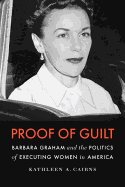
Barbara Graham's life might have sprung from the pages of a pulp crime novel. Born in northern California to a single mother, she was in and out of trouble for loitering, gambling and similar small-time crimes. Then, at the age of 28, she went on trial for murder, along with two male accomplices. All three were sent to the San Quentin gas chamber in 1955, but of the trio, Graham endured in both the popular and the political imagination.
Women were sentenced to death and executed in the 20th century much less frequently than men. In Proof of Guilt, Kathleen A. Cairns explores some of the reasons for this discrepancy. She notes that, in openly expressing her anger and frustration during her trial, Graham failed to live up to the jurors' often sexist notions of how a female defendant "should" behave--and that she likely paid the ultimate price for that, even though her trial was riddled with rights violations, including a confession obtained under illegal and possibly coercive circumstances. Yet Graham's story also helped the growing movement to abolish the death penalty, particularly after it was memorialized in the 1959 film I Want to Live!
Cairns, a historian who often focuses on the incarceration of women (The Enigma Woman; Hard Time at Tehachapi), underlines that narratives have extraordinary power to shape public perception and public policy. Yet she never loses sight of the humanity of her subject and the importance of certainty when using the death penalty. --Dani Alexis Ryskamp, blogger at The Book Cricket

